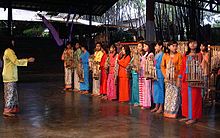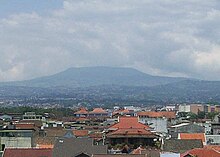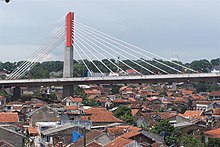Bandung
| Bandung | |||
|---|---|---|---|
|
|
|||
| Coordinates | 6 ° 55 ' S , 107 ° 36' E | ||
| Symbols | |||
|
|||
| Basic data | |||
| Country | Indonesia | ||
|
Geographical unit |
Java | ||
| province | Jawa Barat | ||
| ISO 3166-2 | ID-JB | ||
| height | 768 m | ||
| surface | 168 km² | ||
| Metropolitan area | 1877 km² | ||
| Residents | 2,520,256 (2017) | ||
| Metropolitan area | 6,965,655 (2010) | ||
| density | 15,001.5 Ew. / km² | ||
| Metropolitan area | 3,711.1 Ew. / km² | ||
| founding | 1810 | ||
| Post Code | 40111-40973 | ||
| Telephone code | (+62) 22 | ||
| Website | portal.bandung.go.id | ||
| Other | - | Governor | Ridwan Kamil | - | License plate | D. | |||

Bandung (until 1972: Bandoeng), known as the "City of Flowers" ( Kota Kembang in Indonesian ), is the provincial capital of West Java .
geography
With 2.5 million inhabitants, Bandung is Indonesia's fourth largest city after Jakarta , Surabaya and Medan . From 1940 to 1961 the city's population grew from 230,000 to 1 million people, and by 1990 the city grew to 2 million. The Bandung Raya Plan has been in force since 1987 , through which the city is supposed to grow in a controlled manner outside the city center, mainly to the west and south, for example in the Kopo district and towards Cimahi , but these districts in particular are currently suffering from massive traffic problems, as the important ones Connecting roads (e.g. Jalan Kopo) were not adequately dimensioned. Unofficially, there is talk of three to four million inhabitants today. The local language of the people of Bandung is Sundanese , but almost everyone also speaks Indonesian .
Population development according to the UN
| year | population |
|---|---|
| 1950 | 511,000 |
| 1960 | 902,000 |
| 1970 | 1,170,000 |
| 1980 | 1,452,000 |
| 1990 | 2,035,000 |
| 2000 | 2,138,000 |
| 2010 | 2,398,000 |
| 2017 | 2,520,000 |
history
prehistory
The settlement of the Bandung plateau goes back to the Java man ( Homo erectus ) . Even today, archaeological finds from this period are occasionally found in the Dago area . They are exhibited in the Geological Museum in Bandung.
Early modern age
The oldest written mention of Bandung comes from the year 1488. In 1614 Bandung had 25 to 30 houses. The upswing began in 1786, when the Dutch built a road from Batavia (Jakarta) through the Preanger Mountains to Cirebon as part of the military expansion of the island of Java in order to better protect the country against the English. This Groote Postweg initially passed about 19 km north of today's city center (Alun Alun), and only later was it moved over the main street of Bandungs, today's Jalan Asia-Africa.
Colonial times
In the middle of the 19th century the cultivation of cinchona trees , Assam tea and coffee began in the region around Bandung . Bandung became the center of the plantation region. In 1880 the growing city received a railway connection with Jakarta, which started industrialization and the first tourism. Chinese settled there. The first hotels and cafes opened, and the city built its reputation as the Paris of the East . In 1920 the military headquarters of the Dutch East Indies colony was moved from Batavia to Bandung. The famous Art Deco buildings were also built during this period and Jalan Braga became a promenade for the colonial rulers. The Technische Hogeschool was founded and the government center was built with Gedung Sate northeast of Alun Alun .
In independent Indonesia
From April 18 to 24, 1955, the historically significant meeting of the heads of government from 29 Asian and African countries took place in Bandung , who represented a total of 1.4 billion people ( Bandung Conference ). Among other things, the conference adopted a 10-point program in which these states committed themselves to peaceful coexistence , the principle of national self-determination and to stand up against neocolonialism . The conference gave the national liberation movements a strong impetus.
On April 11, 1963, a serious railway accident occurred near Bandung when the locomotive and the first two cars on an express train from Jakarta to Bandung derailed. One of the cars overturned and fell into a ravine. 37 people died.
Attractions
nature
- Maribaya Waterfalls, northeast of the Dago district
- Tangkuban Perahu volcano ("capsized boat") north of Lembang
- Kawah Putih volcano , south of Bandung
- Ciater hot springs, north of Lembang
- Bandung Zoo
Museums
- Museum Geologi, geological museum
- Jawa Barat Museum, Archeology and Culture of the West Java Province
- Museum Mandala Wangsit Siliwangi, Army Museum
- Museum Gedung Merdeka or Asia-Africa Museum, commemorates the Asia-Africa Conference of 1955
city
Bandung has a collection of tropical Art Deco architecture from the 1920s. The most important Art Deco buildings in the city are the Villa Isola , the Grand Hotel Preanger and the Savoy Homann Bidakara Hotel ; there are also other buildings of this architectural style that are well worth seeing.
- The Jalan Asia-Africa with the Asia-Africa conference building "Gedung Merdeka", various Art Deco hotels such as the "Savoy Homann"
- Jalan Braga with its restaurants, colonial architecture and pubs
- Villa district Ciumbuleuit, Cipaganti, Setrasari north of Jalan Asia-Africa with houses from the colonial times
- For railway fans: the busy train station
- Gedung Sate, the administration building of the West Java government, which bears this name because of its tip that looks like a sate skewer
- Jalan Cihampelas, textile stores
- Jalan Riau, Outlet Street
Culture
- Saung Angklung Udjo, with performance of Angklung music, dances and Wayang Golek
- Institute of Teknologi, Technical University
- Padjadjaran University in the Jatinangor district
traffic
Bandung Airport (BDO / WICC) is located around 5 km northwest of the city center .
The city is connected to the rail network.
education
The ITB ( Institut Teknologi Bandung ), which is highly regarded in Indonesia and trains engineers in various fields, is located in Bandung, along with several other universities . Other universities are the Universitas Komputer Indonesia (UNIKOM) and the Universitas Katólika Parahyangan .
Sports
- Persib Bandung, football club
sons and daughters of the town
- Fred Klein (1898–1990), Dutch painter and father of the painter Yves Klein
- Johan Fabricius (1899–1981), Dutch writer, illustrator, journalist and adventurer
- Henk Badings (1907–1987), Dutch composer
- Roekiah (1917–1945), singer and actress
- Ramadhan KH (1927-2006), writer
- N. John Habraken (* 1928), Dutch architect, architecture teacher, theorist and author
- Eddie de Haas (* 1930), Dutch-American jazz bassist
- Rainer Zepperitz (1930–2009), German double bass player
- Sabine von Diest-Brackenhausen (* 1931), German sculptor and painter
- Friedrich Schmidt-Bleek (1932–2019), German nuclear and physical chemist and environmental researcher
- Jacobus van Lint (1932-2004), Dutch mathematician
- Cornelis Christiaan Berg (1934–2012), Dutch botanist
- Peter Graaff (1936-2014), Dutch general
- Liesbeth List (1941-2020), Dutch singer
- Roderik de Man (* 1941), Dutch composer
- Pierre Mathieu (1943–2014), Dutch volleyball coach
- Robert Kreis (* 1949), Dutch cabaret artist, pianist and entertainer
- Koos Richelle (* 1949), Dutch administrative lawyer
- Nick MacKenzie (* 1950), Dutch singer
- Sandra Reemer (1950–2017), Dutch singer and presenter
- Iie Sumirat (born 1950), badminton player
- Ivanna Lie (* 1960), badminton player
- Dody Satya Ekagustdiman (* 1961), Kecapi player and composer
- Abdullah Gymnastiar (* 1962), Islam preacher
- Andra Matin (* 1962), architect
- Agus R. Sarjono (* 1962), writer
- Marty Natalegawa (* 1963), politician and diplomat
- Aryono Miranat (born 1964), badminton player
- Stewart Bernard (* 1965), Dutch volleyball coach
- Antonius Subianto Bunjamin (* 1968), Roman Catholic bishop
- Ricky Subagja (* 1971), badminton player
- Halim Haryanto (* 1976), badminton player
- Yuli Marfuah (* 1979), badminton player
- Intan Paramaditha (* 1979), writer and lecturer
- Meisya Siregar (born 1979), actress
- Asep Wildan (before 1980-2000 ), volcanologist and geophysicist
- Imam Sodikin (* 1980), badminton player
- Taufik Hidayat (* 1981), badminton player
- Tania Gunadi (born 1983), American actress
- Lita Nurlita (* 1983), badminton player
- Richie Regehr (* 1983), Canadian ice hockey player
- Yoga Ukikasah (* 1985), badminton player
- Tan Joe Hok (* 1987), badminton player
- Febby Angguni (* 1991), badminton player
- Alrie Guna Dharma (born 1991), badminton player
- Yeni Asmarani (* 1992), badminton player
- Dandi Prabudita (* 1992), badminton player
- Suci Rizky Andini (* 1993), badminton player
Town twinning
-
 Braunschweig , Germany , since 1960
Braunschweig , Germany , since 1960 -
 Fort Worth , United States , since 1990
Fort Worth , United States , since 1990 -
 Suwon , South Korea , since 2003
Suwon , South Korea , since 2003 -
 Topoľčianky , Slovakia , since 2009
Topoľčianky , Slovakia , since 2009 -
 Liuzhou , People's Republic of China , since 2009
Liuzhou , People's Republic of China , since 2009 -
 Yingkou , People's Republic of China, since 2009
Yingkou , People's Republic of China, since 2009
TV channel
- Kompas TV
- iNews
- MYTV
- NET.
- O Channel
Web links
- bandung.go.id Official Bandung website of Indonesia (English)
- bandungsae.com Bandung City Homepage (English)
Individual evidence
- ↑ World Urbanization Prospects - Population Division - United Nations. Retrieved July 23, 2018 .
- ^ Meyers New Lexicon in eight volumes . 1st volume. Leipzig 1961, p. 600.
- ^ Peter WB Semmens: Catastrophes on rails. A worldwide documentation. Transpress, Stuttgart 1996, ISBN 3-344-71030-3 , p. 168.










